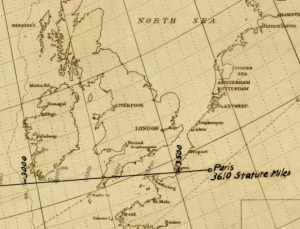Famed for accomplishing the world’s first successful transoceanic crossing in an airplane, Charles Lindbergh is considered by today’s pilots an aviator’s aviator. With only a clock, a compass, and a drift sight he didn’t use, Lindbergh changed the world with his fortunate arrival to France after a grueling and death-defying flight. To cross the vast and featureless open ocean without the aid of today’s modern navigational aids, Lindbergh used the classic navigational method that countless sailors navigating the ocean he flew over had used for centuries: Dead Reckoning. By flying a known heading, keeping track of time, controlling speed, and accurately correcting for wind drift, Lindbergh’s dead reckoning propelled him to a glorious and fortunate arrival to Paris, France on May 21st, 1927.
I use the word “fortunate” on purpose. It just so happens that the conditions for the flight were highly ideal and wind drift had little factor in the flight. Another day and in different conditions, he may not have been so fortunate. In fact, Lindbergh later came to his own realization just how lucky he may have been when after departing Havana, Cuba in the Spirit of St Louis to Florida, he became temporarily disorientated (remember fellow pilots, we’re never “lost”, right?). By temporarily disorientated I mean off course by 300 miles. That’s right, 3-hundred miles! So there you have it. The aviator’s aviator, the man who just successfully crossed the Atlantic, off course by 300 miles.
So what does this mean to pilots today? First, Lindbergh demonstrated the power and utility of what seems to be becoming a lost and life-enhancing, and even life-saving skill: Dead Reckoning. Second, all aviators, even the best among us, are vulnerable and we will only fly as good as our skills, knowledge and tools can take us. Finally, knowing Lindbergh and other aviators from his era went on to accomplish additional amazing feats in improving aerial navigational techniques, we can assume there are some important lessons to be learned from Lindbergh’s reaction to his experience getting “lost” on his way to Florida.
For all these reasons and more, I look forward to presenting an FAA Wings Safety Seminar on April 18th, 2015 at 9 am called “Dead Reck’n - Pilotage and Dead Reckoning for Safety” at the Ann Arbor Municipal Airport in the basement classroom of the terminal building. Please pre-register here if you plan to attend. The seminar is free of charge and counts towards 1 Knowledge Credit for the Wings safety program.
As a flight instructor I’m always anxious to help my students gain some Lindbergh-esque navigation skills that will carry with them for the rest of their lives and piloting career. But as a geographer and competitive orienteering athlete I also enjoy the continuous process of improving and refining my own navigation techniques whether by ground or air, and sharing that with others. I’ve also found some useful transferability in techniques and skills between aerial and ground navigation, so I will share some of those pointers at the seminar as well. Here is a brief tentative outline of the seminar in preview:
- Society, We Have a Spatial Awareness Problem…
- Pilotage and Dead Reckoning Defined
- Where Does that “Dead Reckoning” Term Come From?
- Even Lindbergh Got Lost, and Earhart Died. So What?
- This is a Map
- Pilotage Techniques
- Dead Reckoning Techniques
- I Didn’t Know Orienteers Could Hangar Talk!
- GPS’s and EFBs — Kenny Rogers says, “You’ve got to know when to hold ’em, know when to fold ’em…”
Looking forward to talking about this important flight safety topic, but you and I both are probably looking forward to the free donut(s) even more. See you there!

